About:Nancy J. Cohen
Posts by Nancy J. Cohen :
Recent Reads – Book Reviews
Readers are always asking, who are my favorite authors? So I’ll share with you some of my recent reads. My tastes vary from romance to mystery to scifi/fantasy. At any time, I’ll be reading more than one book. I have not included the historical romances I’ve read, because these are mostly older books I have accumulated from conferences over time. They’re my comfort books that I reach for when I need a pleasant escape. You can see all of my reviews over at Goodreads. So here are the other recent titles from my shelves that I would rate at 4 or 5 stars.

The Detecting Duchess by Kate Parker (Historical Mystery)
Soon-to-be Duchess and Victorian bookshop owner Georgia Fenchurch gets embroiled in another murder mystery just days before her wedding to the Duke of Blackford. The case involves stolen Egyptian gold, governmental diplomats, and a missing investigator. As the bodies pile up, Georgia wonders if she’ll be able to make her nuptials. Can she find the killer before the wedding bells ring, or will it be her death knell instead? Another charming addition to a delightful series. http://amzn.to/2t1oKeV
The Magdalen Girls by V.S. Alexander (Historical Novel)
This haunting story about a girl forced into servitude at an Irish laundry run by nuns is gripping in its tale of betrayal, despair, hope, and faith. Vivid historical details bring the story to life as readers suffer along with the wrongly accused young woman, Teagan Tiernan. As she fights for survival, she befriends two other girls, which makes their monotonous routine somewhat bearable. Insisting on her innocence, she never gives up the quest for freedom despite harsh living conditions, forced labor, and humiliating punishments. This dark blot on the church’s history exposes a sorry past of cruelty in the name of love and redemption. http://amzn.to/2srG7si
Honor’s Flight by Lindsay Buroker (Science Fiction)
Book two in the Fallen Empire series has Captain Alisa Marchenko and crew arriving on her home world. All Alisa wants is to retrieve her daughter, but obstacles lay in her path. Her crew members are wanted men, and everywhere they go on this imperial planet brings danger their way. Alisa finally reaches her daughter’s location, but things don’t go the way she’d planned. Her late husband kept a deep secret from her that affects her entire family. Now her quest must continue as she faces a greater foe. This series has me hooked. It’s reminiscent of Firefly and has a sympathetic heroine with a relatable goal. http://amzn.to/2srKO5E
Star Nomad by Lindsay Buroker (Science Fiction)
This first book in the Fallen Empire series finds former Alliance pilot Captain Alisa Marchenko looking for a way off the planet where she’s been recovering from injuries sustained in battle. The war is over, and the Alliance won. She needs to retrieve her daughter and move on with her life. But she can’t afford supplies even if she can reclaim the ship that brought her there. Her only solution is to take on paying passengers. Thus she takes off with a misfit group of comrades, most of whom guard secrets that could prove dangerous. Alisa and friends get into one scrape after another while each one chases their own elusive goal. Will she survive long enough to find her daughter? And why does she feel attracted to the imperial Cyborg soldier when she should fear him? Can she betray him if the time comes? Readers won’t want to stop with this one volume. You’ll want to follow Alisa and her motley crew on their next rousing space opera adventure. http://amzn.to/2rgCAZx
A Front Page Affair by Radha Vatsal (Historical Mystery)
Enterprising journalist Kitty Weeks is covering a social affair for the ladies’ page in early 1900s New York when a man is shot dead in the stables. Her assignment turns into a series of interviews of various guests present that day. Using her unique skills, she’s able to gather information on the suspects. But things become personal when a couple of Secret Servant agents implicate her father in a scheme that might have a broader reach. Wartime is on the horizon. How much is Kitty willing to risk to learn the truth? Kitty Weeks is a delightful heroine and so are the supporting characters that populate this historical mystery. I’m eagerly looking forward to the next installment. http://amzn.to/2rgTVl3
The Keeper by David Baldacci (YA Fantasy)
Vega Jane and her companions traverse the dreaded Quag in this second book of Baldacci’s famed fantasy series. She’ll need all her magical powers to survive the different levels. Each of the five circles comes with its own dangers. Challenged at every corner, Vega must rely on her own wits and instincts plus the allies she meets along the way. Will she and her best friend Delph defeat the creatures that live in the wilderness? Or will they be lost in the Quag forever? This action-packed tale will have readers rapidly turning pages and eager for the sequel. If you like quest stories and monsters, this one is for you. http://amzn.to/2t1gATQ
Really, Truly Dead by Maggie Toussaint (Mystery Novella)
Lindsey, a journalist, returns to her hometown only to find her father arrested for the murder of the town judge. The man didn’t lack for enemies. He was about to put the local shrimpers out of business by not renewing their dock lease. He owned a sleazy motel and had a mistress or two on the side. But it doesn’t look good for Lindsey’s father, who was having an affair with the judge’s wife. Meanwhile, the sheriff has his eyes on Lindsey, and those heated glances he gives her have nothing to do with the case and everything to do with romance. Can she solve the case and clear her father’s name so she can follow her heart? http://amzn.to/2t1kA6K
New Canaan by M.D. Cooper (Science Fiction)
General Tanis Richards wishes she could enjoy a peaceful life at New Canaan, her new home. But planetary defense is her responsibility, and she has secret shipbuilding facilities to expand her fleet. War looms on the horizon between three factions, and they’ll soon all head her way to gain the colony’s technology. This book is part of the Aeon 14 series and is another action-filled adventure with political intrigue, espionage, and the inevitable space battle. I’ve been hooked since book one on this series. http://amzn.to/2tlxsUJ
Duchess of Terra by Glynn Stewart (Science Fiction)
Book Two in the Duchy of Terra series finds newly titled Duchess Annette Bond as the leader of Earth, a.k.a. Terra, and a subject of the A!Tol empire. As she gathers her new government, they wrestle with how to meet the Imperium’s demands for military warships without giving away Earth’s resources. Meanwhile, Kanzi slavers build forces on the border. It’s a race against time as Annette battles to protect her planet while ceding to the wishes of her new superiors. It doesn’t help that she also faces holdouts of the old Earth resistance, and they threaten the safety of her people. With threats from within and without, Annette has her hands full. But as we’ve seen in book one, she is very capable of juggling multiple balls at the same time. Somehow Earth will survive, but they may need to find new allies along the way. This fast-paced story alternates between political manipulations and space battles. You’ll be rooting for Annette to succeed. I’m ready for the sequel. http://amzn.to/2t1j5Wp
The Queen’s Accomplice by Susan Elia MacNeal (Historical Mystery)
This installment in the Maggie Hope series seems darker than most with a serial killer on the loose in London during WWII. I’ve enjoyed these stories with espionage, intrigue, and adventure but less so this one. If I want to read about women being brutalized, I’ll pick up the newspaper. I prefer lighter fare in my reading. More interesting to me was the puzzle of what had happened to Maggie’s half-sister and to another female operative in Paris. Let’s hope the author leaves the serial killers behind in the next book and gives us a good spy thriller in France. While not as much for my taste, this story is well-written with a likeable heroine. http://amzn.to/2t1k6gS
Caught Dead Handed by Carol J. Perry (Mystery)
This first book in “A Witch City” mystery series is a delightful cozy set in Salem, Massachusetts. Reporter Lee Barrett returns to her home town to move in with her Aunt Ibby and to hopefully get a job at WICH-TV. When she’s passed on the field reporting job she wanted and is offered a role as call-in psychic instead, she jumps at the chance to get her foot in the door. Is it a coincidence that she’s just discovered the body of her predecessor drowned in the sea? And when Lee starts seeing images in a crystal ball, how does she know if Ariel’s spirit is channeling through her, or if she’s developing powers of her own? Something isn’t right at the TV station, and the more Lee digs into things, the deeper she gets in trouble. A charming debut. http://amzn.to/2rv9VPM
The Finisher by David Baldacci (YA Fantasy)
In the town of Wormwood, Vega Jane acts as a Finisher at the Stacks without questioning her destiny until she sees the unthinkable. Quentin Herms runs away into the Quag, the bordering realm that surrounds Wormwood and where no one is ever supposed to go. The forest harbors nothing except monsters and death. Or so she’s been told. But when the town leaders lie about Quentin’s disappearance, she grows suspicious at their obvious cover-up. Seeking answers, she sneaks into the Stacks at night and discovers secrets beyond her imagination. She also acquires instruments of power and begins to question the very origin of her world. With the support of the stalwart Delph, she plots her own escape. But first she must survive a series of combat and face the wrath of the powerful Morrigone who wants her dead. Excellent world building in this gripping novel will have readers frantically turning pages to see if Vega Jane achieves her goal. The story reminded me of City of Ember that has its young protagonists seeking escape from a similarly mysterious town with nothing but blackness beyond. Or is there more? But while the concepts are similar, the worlds are each uniquely distinctive. http://amzn.to/2tlsOGj
Note: I am a member of the Amazon Affiliate Program and these are affiliate codes.
GIVEAWAY
Enter to win a $25 Amazon/BN gift card from Booklover’s Bench

Sign up for my Newsletter for my latest book news, giveaways, bonus content, and events. Free book sampler for new subscribers.
Pandora – The World of Avatar
We visited Pandora at Disney’s Animal Kingdom and set out to explore the world of Avatar. Our entrance into this magical land took us past a lounge that looked inviting.


We skipped the new rides, not having fast passes and not caring to wait two hours in the standby line. It was delightful to stroll around and view the amazing flora and fauna. Disney did a wonderful job making you feel you’re on an alien planet.




Mountains rise in the distance, past this floating masterpiece, while musicians welcome visitors to their land.



Hungered by our journey, we entered the canteen where healthful choices tempted us. I had the chicken bowl with rice and vegetable slaw. Others in our party had cheeseburger pods or vegetable curry pods. My non-alcoholic drink, a Pandoran Sunrise, was green and tasted like melon juice.


Inside the gift shop, you can buy all sorts of theme-related wares. It was fun to browse although we left with our wallets intact.



It took us a couple of hours to stroll around. If you go on the rides, allow more time. You’ll still have the rest of the day free to explore the Animal Kingdom. I love the lush greenery of this theme park anyway, and the new addition adds to the allure.
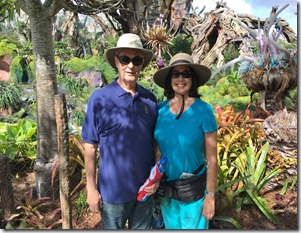
View more photos and videos here: https://www.facebook.com/NancyJCohenAuthor
GIVEAWAY
Enter Here to win a $25 Amazon/BN gift card from Booklover’s Bench

Sign up for my Newsletter for my latest book news, giveaways, bonus content, and events. Free book sampler for new subscribers.
Mystery Movies
MYSTERY MOVIES and TV SHOWS
In addition to the classics like Sherlock Holmes and Agatha Christie, here are some of my favorite films in the mystery genre or movies involving writers. A happy ending is a must for my taste. This list does not include the Hallmark Channel mystery movies of which I’m also a fan.

FILMS
AMERICAN DREAMER with JoBeth Williams and Tom Conti.
This classic tale of intrigue is one of my favorites. A romance novelist wins a contest and a trip to Paris. En route to the awards luncheon, she’s in an accident and suffers a head injury. She wakes up believing herself to be the heroine in her favorite books. A spy caper follows that’s all too real, as she teams up with the author’s handsome son who thinks she’s a nutcase. That is, until someone tries to kill them. http://amzn.to/2qZVEhl
DROWNING MONA with Danny DeVito and Bette Midler.
This funny whodunit in a small town has a cast of wacky characters. Classic example of a cozy. http://amzn.to/2rkArzR
GOSFORD PARK with Helen Mirren and Jeremy Northam.
This is an English drawing room mystery that takes place at a country estate. Aristocrats and servants alike have secrets that slowly unravel during a hunting party weekend. Albeit a bit slow-paced, this film requires repeat viewings to catch the nuances. http://amzn.to/2rklnC8
HER ALIBI with Tom Selleck and Paulina Portzkova.
This hilarious escapade finds mystery novelist Phillip Blackwood falling for a suspected murderess while he searches for inspiration to unlock his writer’s block. Did the mysterious and beautiful foreigner have a hand in the victim’s death? If so, was he foolish to vouch for her alibi and bring her home? And are the accidents that occur after her arrival truly accidents, or is Philip next in line for his guest’s lethal hijinks? http://amzn.to/2qjtafC
MANHATTAN MURDER MYSTERY with Woody Allen and Diane Keaton.
A Manhattan housewife thinks her next door neighbor is a murderer. She enlists her friends to search for clues. Probably my favorite Woody Allen film out of all of them. http://amzn.to/2qZEEIb
MURDER 101 with Pierce Brosnan.
English professor Charles Lattimore assigns his class to plan the perfect murder as a literary exercise. When he’s framed for a woman’s death, he has to find the killer before the detective on the case finds him. Will his students help him solve a real murder, or is one of them guilty? http://amzn.to/2qje0qK
MURDER BY THE BOOK with Robert Hays.
A mystery novelist thinks he’s hallucinating when his hero appears in front of him and talks back. He’s been thinking of changing to a new series and scrapping the sleuth, but now he needs the fellow’s help to solve a real murder. http://amzn.to/2qZrQzF
MY COUSIN VINNY with Joe Pesci, Ralph Macchio, Marisa Tomei, and Fred Gwynne
In this funny courtroom drama, a New York lawyer on his first case defends two fellows in Alabama who are mistakenly accused of murder. Watch for the clues in this hilarious mystery. http://amzn.to/2qnMisB
THE BOY NEXT DOOR with Dina Meyer and Cory Monteith.
A romance writer goes on a retreat to a small town to seek inspiration for her next story. When her next door neighbor is found dead, the chief of police suspects her. Even when her place is ransacked and someone tries to run her off the road, he discounts her theories and refuses to look into the incidents. It’s up to our heroine to prove her innocence and uncover the killer before his next attack turns fatal. http://amzn.to/2qZQXEi
TV SHOWS
THE BROKENWOOD MYSTERIES with Neill Rea and Fern Sutherland.
I’ve bought the DVDs. Otherwise, you can find this show on the Acorn TV Channel. http://thebrokenwoodmysteries.com/
Detective Senior Sergeant Mike Shepherd and Detective Constable Kristin Sims solve mysteries involving a limited number of suspects, most of whom know each other, in a distinct setting and with a definite sense of humor. Emphasis is on the relationships between characters and personal motives rather than forensics. Each episode is a perfect example of a cozy mystery despite the lack of an amateur sleuth. http://amzn.to/2qjcPYl

MISS FISHER’S MURDER MYSTERIES with Essie Davis and Nathan Page.
http://www.abc.net.au/tv/programs/miss-fishers-murder-mysteries/
The Honourable Miss Phryne Fisher solves crimes in 1929 Melbourne, Australia. Essie Davis plays the lead while Nathan Page plays her romantic interest, Detective Inspector Jack Robinson. Warning: Miss Fisher’s spectacular outfits threaten to steal the show. http://amzn.to/2qjwVle

MIDSOMER MURDERS with John Nettles and Jane Wymark.
A police detective and his deputy solve murders in small town England. Some people love this show. I couldn’t get into it but it might appeal to you. http://amzn.to/2qSu0Cu
ROSEMARY AND THYME with Felicity Kendal and Pam Ferris.
Two ladies in England solve mysteries together. One is a plant pathologist. The other woman is separated from her husband. I haven’t watched too many of these but they caught my interest. http://amzn.to/2qj87ty
Disclosure: I am a member of the Amazon Affiliate program. These are affiliate links.
So here you go. If you have some free time this weekend, look up these films and have a good time. Keep watch for Murder on the Orient Express, an upcoming theatrical release and remake of the classic Agatha Christie tale, with Johnny Depp, Judi Dench, and Penelope Cruz in an all-star cast.
Sign up for my Newsletter for my latest book news, giveaways, sales, and events. Free book sampler for new subscribers.
Brookside Gardens
Brookside Gardens is a fifty-acre horticultural garden located inside Wheaton Regional Park in Maryland. It’s one of my favorite spots to visit in the area. Flowers, ponds, and wooded trails make for a pleasant escape from urban congestion. We met our niece there for some quality time together.









Bethesda has its fans. We headed on foot to the shopping district nearest the Hyatt Regency. Here are some landmark businesses.
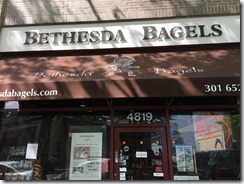
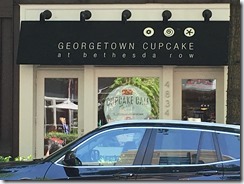
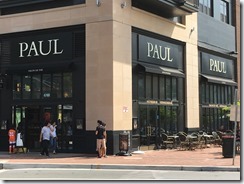
If you have a car and some free time while you’re in the area, Brookside Gardens is worth the visit. Also look for the Nature Center nearby. Wear your walking shoes and a hat.
SEE ALL PHOTOS HERE
Giveaway!

Enter to win a $25 Amazon/BN gift card from Booklover’s Bench
<><><>
Sign up for my Newsletter for my latest book news, giveaways, sales, and events. Free book sampler for new subscribers.
Washington D.C. Wanderings
After visiting the Library of Congress, we strolled past the Supreme Court. Here I am by the steps of this impressive building. The structure is inspiring, making you hope that justice truly is being served inside its doors.




Across the street is the Capitol Building, always an awe-inspiring sight. The tall Washington Monument reaches toward the sky at the other end of the Mall. Having been in town before, we’d already seen many of these sites and museums.


The buildings where our Senators and House representatives meet or have their offices are impressive as well.


We passed patches of greenery, mini-parks with flowering bushes and graceful trees.



Our path took us to Union Station, where we browsed the shops before taking seats in the bustling East St. Café for a leisurely Asian lunch.





Then we took the Metro back to Bethesda.
SEE ALL PHOTOS HERE
Giveaway!

Enter to win a $25 Amazon/BN gift card from Booklover’s Bench
<><><>
Sign up for my Newsletter for my latest book news, giveaways, sales, and events. Free book sampler for new subscribers.
Library of Congress
Visiting the Library of Congress in Washington D.C. is an awe-inspiring adventure. As you climb the steps toward the entrance, you’ll be impressed by the massive size of the structure.


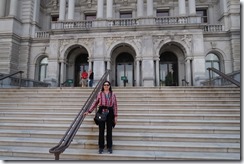
Inside the Thomas Jefferson Building, we passed through a bag check and then had to figure out where to go. Everywhere we looked, the architecture beckoned. I could have stood all day gazing at the intricate ceilings, wall décor, and majestic columns.







Look at these folks. They don’t look too happy. Maybe they’re spirits trapped in the walls.
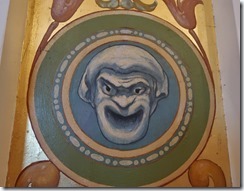

After we admired the Great Hall, we headed upstairs, planning to work our way down. Here are some photos from an exhibit titled “Exploring the Early Americas.”

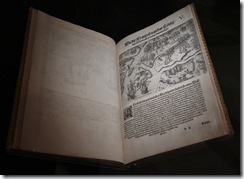

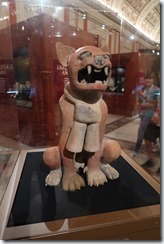
We saw “Echoes of the Great War” about WWI and a display called “Drawing Justice.” The latter contained paintings of true-life courtroom dramas. I never knew such a field of artwork existed. Famous trials were depicted here in vivid details.
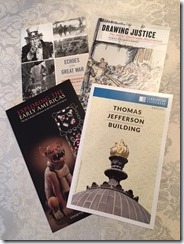
I liked seeing Jefferson’s library, or at least a facsimile of books he’d kept there. Some are originals and others are reprints.
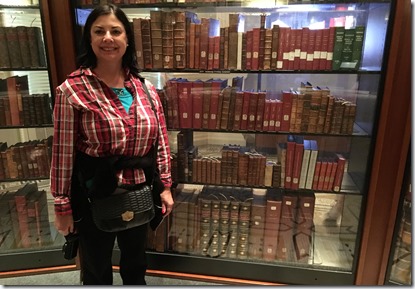

The main Reading Room drew me like a lawn mower to a blade of grass. Up a flight of stone steps, we paused on a landing where we could peer below at the hallowed halls. Researchers sat at desks while other archways led to more reading rooms beyond.

Downstairs, we viewed the Gutenberg Bible behind its glass case.


By now, we’d become tired and hungry, and so we passed on the other exhibits. We couldn’t help stopping in the gift shop. We left with our imaginations enriched and our wallets a few dollars lighter.
SEE MORE PHOTOS HERE
Giveaway!

Enter to win a $25 Amazon/BN gift card from Booklover’s Bench
<><><>
Sign up for my Newsletter for my latest book news, giveaways, sales, and events. Free book sampler for new subscribers.
Murder by Manicure Audiobook
Murder by Manicure Audiobook, book #3 in the Bad Hair Day Mysteries, is now available at Audible, iTunes, and Amazon. Narrated by the talented Mary Ann Jacobs.

Hairstylist Marla Shore joins a fitness club to get in shape but discovers a dead body instead of an exercise routine. Jolene Myers, a client at Marla’s salon, has drowned beneath the frothing waters of the whirlpool. When Detective Dalton Vail determines Jolene’s death was no accident, Marla decides to give her deductive skills a workout and help solve the case.
Excerpt:
Arnie wrung his hands. “She’s a former classmate. We went to high school together, and she had a crush on me. The ugliest dog in school, that was her. A real fresser, too. Ate everything in sight. And now she’s here! Oy vey, what am I going to do?”
“What do you mean?” Marla glanced furtively at the reception area, hoping her next client would be delayed. Arnie needed her, making her nurturing instincts surface.
“Hortense is in town. She wants to see me. She’s on her way over here.”
“So? You can exchange a few reminiscences and then she’ll leave.”
He leaned forward, breathing heavily. “You don’t understand. She likes me. Hortense said she’d been sorry to learn my wife had passed away, and how difficult it must be for me to raise two kids on my own. I could tell from her tone of voice that she’s still interested in me.”
“Hortense never married?”
“She’s divorced.” His brows drew together. “I said the only thing I could think of to get rid of her. I told her I was engaged.”
Marla smiled gently. “Arnie, how could you? The poor woman probably just wants an hour of your time.”
“No, no. She’s moving back to Palm Haven. I had to discourage her. Tell me you’ll play along. I knew you wouldn’t mind, since you’re such a good friend.” Taking her by the elbow, he steered her into the rear storeroom. “She’ll come to the salon. Tell her off for me, would you please?”
“Me?” She wrinkled her nose. “Why would she come here?”
His eyes grew as round as bagel holes when the front door chimed. “That may be Hortense,” he croaked. “Marla, you have to save me.”
How bad could this woman be to make Arnie so afraid of her? Intensely curious, Marla strode toward the reception desk.
The woman standing by the counter wasn’t the ugly horse Arnie had depicted. Nor was she Marla’s next client. A tall, sexy blonde, she wore a short skirt and bolero jacket with black high heels. Wavy hair cascaded like a river down her back. A delicate lilac fragrance wafted around her.
“This is Marla Shore,” said the receptionist. “She owns Cut ’N Dye.”
“Hi, I’m Hortense Crone.” The woman grinned, displaying a row of perfectly aligned teeth. “I was told Arnie Hartman came in here. Y’all can call me Jill; I use my middle name now,” she added, extending her hand.
Marla exchanged a firm handshake. This was Hortense? A bubble of laughter welled within her. Would Arnie be surprised to see what a looker his classmate had turned into!
“He’s in the storeroom. I’ll get him for you. Hey, Arnie,” she called, eagerly anticipating his reaction. “Someone here to see you.”
All eyes in the salon turned in their direction as Arnie shuffled toward the front, gaze downcast like a condemned man.
“Congratulations, Arnie,” crooned Hortense. “You have a lovely fiancée.”
Marla, entertained by Arnie’s sudden, shocked glare as he raised his eyes, didn’t catch on right away until she heard snickers from her staff.
“Don’t tell me,” she said to Hortense. “Arnie told you we’re engaged?”
Listen to a sample from Murder by Manicure Audiobook
ORDER NOW



If you haven’t tried audiobooks, here are some good reasons to check them out:
• A story can come to life in a new way when read by a professional narrator.
• You can listen while working out, driving, or doing chores around the house.
• If you have trouble reading due to vision problems, you can listen to a story instead.
• If you buy the ebook along with the audiobook, you can switch devices using Whispersync and never lose your place.
How to listen to audiobooks on your phone, Kindle, tablet, or computer: https://www.audible.com/mt/Apps
CLICK TO TWEET
Giveaway!

Enter to win a $25 Amazon/BN gift card from Booklover’s Bench
<><><>
Sign up for my Newsletter for my latest book news, giveaways, sales, and events. Free book sampler for new subscribers.
Disney Ramblings
We visited Epcot at Disney World again for the annual Flower and Garden Festival. The colorful flower displays were as beautiful as always.



Bypassing the crowds at Future World, we strolled around World Showcase to sample the foods in the various marketplaces. We headed right toward Canada, stopping by to get the beef tenderloin tips in a flavorful mushroom sauce along with mashed potatoes and cooked carrots. The meat was a bit chewy for my taste. Cost $6.50 for a generous portion.


We moved on to the United Kingdom for the corned beef and cabbage which my husband ate. It’s a dish he likes at any time. Cost $5.50 per portion.



At France, we noticed the fast-food café had moved toward the back while its former space is now occupied by an ice cream shop.
Next on the menu were the potato pancakes with applesauce from Germany. These are always good. Cost was $3.75. Dessert was the winner: blueberry buckle with pepper berry sorbet at The Berry Basket. $4.25 each. Well worth the visit!

As if this wasn’t enough eating for the weekend, we took a walk the next day at Disney Springs. Planet Hollywood has reopened since our last visit. The dome looks a lot better without its prior garish colors. The Edison is still under construction but looks to be a big themed restaurant when it’s finished. Not much else had changed that we could notice.

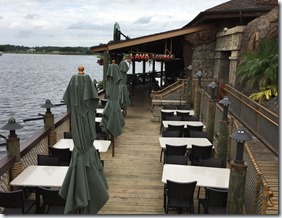

We ate lunch at the Boathouse, where I dined on this delicious crab and avocado dish. Fully sated, we returned to our condo to rest for the afternoon.


CONTEST

Enter to win a $25 Amazon/BN gift card from Booklover’s Bench
<><><>
Sign up for my Newsletter for my latest book news, giveaways, sales, and events. Free book sampler for new subscribers.
Tips for the Hot Pitch
Pitching Your Novel to an Editor/Agent
Are you preparing for a conference but your knees get shaky at the thought of an editor/agent appointment? Be prepared, not scared. Begin your ten minute pitch session by offering the editor or agent a handshake along with your name. If you have a business card, hand it over. Sit down and smile and state your story’s genre and word count. Mention which imprint at the publishing house you are targeting. Then continue with the following.
Do not bring your manuscript. Do not ramble on with plot details. Do have a completed book ready to submit. Do hit these high points and then let the editor do the talking.

LOG LINE: When planning your pitch, think in terms of Key Words and Hot Premises for a one line summary of your work. Look at TV Guide for examples of log lines. Examples of key words are “humorous cozy”, “legal thriller” or “courtroom drama.” Be prepared to compare your work to movies or other authors in the same genre.
Facials Can Be Fatal: Salon owner Marla Vail’s new day spa hits a snag when a client dies during a facial in this killer cozy mystery.
Warrior Lord: A fantasy wedding in Las Vegas turns into a nightmare when contest winner Erika Sherwood realizes she’s married an alien.
CHARACTERS: Don’t crowd your pitch with too many character names. In a mystery, stick with the sleuth, victim, and killer. In a romance, just the hero and heroine count. Identify your main characters by means of an adjective and a noun. i.e. sassy hairstylist, scandalous socialite, shy schoolteacher, reckless ranger, dashing detective.
OPENING HOOK: Describe the initial set up or how the story opens.
Permed to Death: Hairstylist Marla Shore is giving her client a perm when she goes into the back room to get some clean towels. She hears a loud crash, rushes back into the salon, and finds her client dead in the shampoo chair.
Warrior Prince: Mythology student Nira Larsen receives a summer job offer she can’t refuse—to act as a tour guide for a team of warriors from another planet.
MOTIVATION: In a romance, this is the internal conflict that keeps the couple apart. In a mystery, this would be why the sleuth feels compelled to get involved.
Hanging by a Hair: Marla’s husband is implicated in the murder of their neighbor. A police detective, he’s removed from the case. She means to find the killer, clear her husband’s name, and make the neighborhood safe again.
Warrior Lord: Magnor is a Tsuran swordsman who has been shunned by his tribe. Evidence pointed his way when his brother-in-law was found murdered. He took the fall for his sister, who lied him to gain his property. He doesn’t trust women who might betray a man, nor does he consider himself worthy of love since he lost his honor.
RESOLUTION: How will your characters grow and change by the end of the story? In a romance, what compromises will each person make to bring about a HEA ending? In a mystery, what insight does the main character have about herself by the final chapter?
UNIQUENESS: How is your book different from others in the genre? What special knowledge or fresh angle do you have to offer? Does the theme deal with any issues in today’s news?
SERIES OR SINGLE TITLE: If this is meant to be a series, give the overall series title and brief blurbs for the next books. If you have an overall arc for your main character, here’s where you can mention your protagonist’s inner journey.
If the editor or agent shows interest, you can briefly mention the continuing characters that will populate your stories. In the Bad Hair Day Mysteries, these include Detective Dalton Vail, who becomes Marla’s love interest. There’s her mother and other relatives, her salon colleague Nicole, and her friends Tally and Arnie. These people are part of the world you are creating. They’ll become friends to your readers.
MARKETING: What is your series marketing hook? i.e. “It’s Murder, She Wrote in a beauty salon with a South Florida slant.”
Do you have a platform? A niche audience? How do you plan to promote the book? When I was starting out with my series, I might have said: “Besides appealing to mystery lovers who like humor and a touch of romance, I’ll target people in the beauty business such as hairstylists, manicurists, and salons owners. Plus, Florida is a popular site for mysteries. People who’ve visited here or who live here like to read about familiar places.”
Are you set up with a website, blog, Facebook page, Twitter? Are you prepared to do a virtual blog tour, book trailer, and more? Show that you’re willing to work hard as a partner in marketing your work.
SELL YOURSELF: Ultimately, it’s your energy and enthusiasm that count. You have to be someone the agent or editor wants to acquire as a client. Be professional and courteous at all times. It may even be that you speak about something else you have in common, i.e. trying new recipes or touring the city sights. Then when you send in your proposal, your cover letter can state: “I enjoyed our discussion at the XYZ conference about seafood. If you recall, I’d mentioned my book….”
Restrict your pitch to the above essentials. Avoid descriptions of plot details, physical character traits, and your own personal history unless it relates to the story.
CONCLUDING THE INTERVIEW
Thank the editor or agent for their time. If they request you send them something, ask if they want to see a query letter, proposal, or the full manuscript. Also, do they prefer an email or snail mail submission? Ask for their business card before you shake hands again and depart.
FOLLOW UP: At the editor or agent’s request, mail your work to them afterward. If it’s via snail mail, which is unusual these days, mark the package “Requested Material.” If it’s an email, be sure to put in the subject line a reference to where you met, i.e. SleuthFest Conference Author. Then cross your fingers and hope for the best!
CLICK TO TWEET
Did you miss my earlier posts on Getting an Agent? Go here for Part 1 and Part 2.
<><><>
Sign up for my Newsletter for my latest book news, giveaways, sales, and events. Free book sampler for new subscribers.